Live on the homepage now!
Reader Supported News
Several new studies document the current court’s distinctive insistence on its dominance and the justices’ willingness to use procedural shortcuts to achieve it.
But a burst of recent legal scholarship makes a deeper point, saying the current court is distinctive in a different way: It has rapidly been accumulating power at the expense of every other part of the government.
The phenomenon was documented last month by Mark A. Lemley, a law professor at Stanford, in an article called “The Imperial Supreme Court” in The Harvard Law Review.
READ MORE 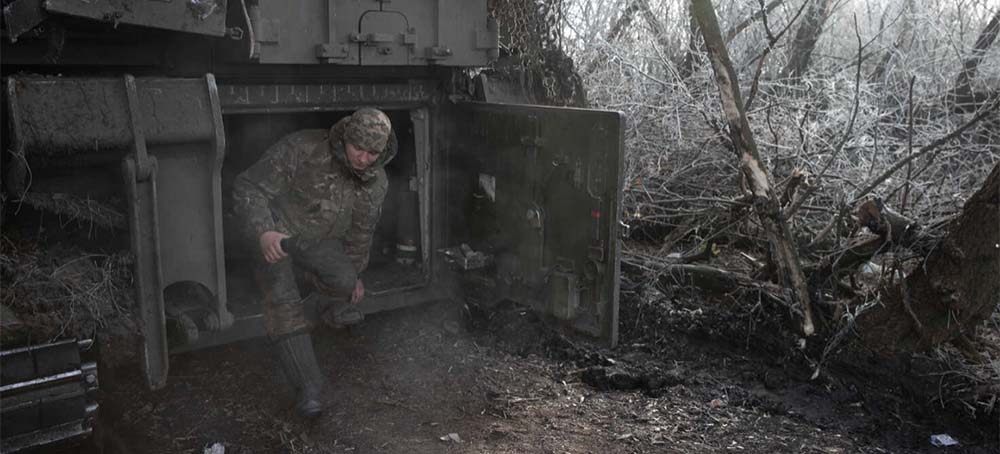 Ukraine. (photo: Tyler Hicks/NYT)
Ukraine. (photo: Tyler Hicks/NYT)
ALSO SEE: The US Will Give Ukraine Patriot Missiles for the First Time
The officials, who spoke on the condition of anonymity because of concerns about Mr. Zelensky’s safety, cautioned that the plans were not final and could change. The risks involved in such a visit — with the wartime leader leaving his country for the first time since Russia invaded Ukraine — are high, and tight secrecy would surround any such effort.
Mr. Zelensky is expected to join Mr. Biden at the White House for an announcement on Wednesday — likely to include a pledge by the Biden administration of a new round of military assistance — before heading to Capitol Hill for a prime time speech, according to two people familiar with the planning.
READ MORE 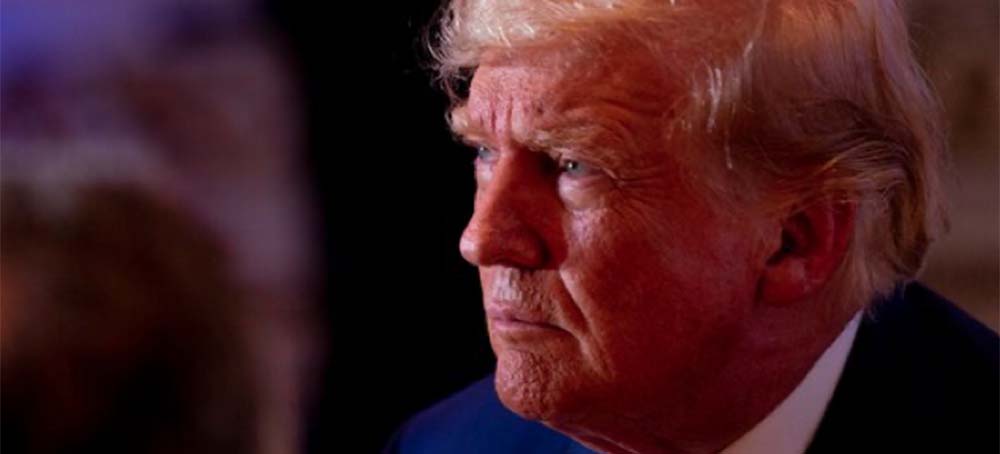 Former president Donald Trump’s tax returns will be made public by Congress. (photo: Andrew Harnik/AP)
Former president Donald Trump’s tax returns will be made public by Congress. (photo: Andrew Harnik/AP)
ALSO SEE: IRS Asleep at the Wheel on Trump Audits, House Tax Writers Say
Panel says IRS did not perform mandatory audits during Trump’s first two years in office despite signs there was much to investigate
Democrats have for more than three years pushed to make Trump’s tax returns public, and the documents were finally made available to the Ways and Means Committee late last month after the Supreme Court denied a last attempt by Trump to withhold the records.
After the vote, the committee revealed that the Internal Revenue Service did not audit Trump’s returns during his first two years in office, despite a rule mandating such reviews, and never completed any audits while he served.
The IRS began its first audit of Trump’s returns on the same day that Ways and Means Committee Chairman Richard E. Neal (D-Mass.) sent a written request in April 2019 for the information and then assigned the bulk of the work to just one agent, the panel said.
Democrats on the committee said their investigation suggests Trump had not been correct in claiming during his 2016 campaign that he could not release the records himself because of an ongoing IRS audit. They also urged Congress to adopt a new law ordering mandatory IRS reviews of presidential taxes and the public release of some information.
That IRS’s inaction came despite the fact that Trump’s tax forms raise serious questions about how he used deductions to avoid paying taxes in some years, according to a separate report released on Tuesday by the Joint Committee on Taxation.
Rep. Lloyd Doggett (D-Tex.), a member of the Ways and Means Committee, said in a CNN interview that the returns showed there were “tens of millions of dollars in these returns that were claimed without adequate substantiation.”
It was not possible to immediately verify the Democrats’ allegations because the returns have not yet been released to the public. They are expected to be released in coming days after sensitive information such as Social Security numbers are redacted.
Trump’s campaign rebuked the committee’s vote as a politically motivated attack.
“This unprecedented leak by lameduck Democrats is proof they are playing a political game they are losing,” his campaign said in a statement. “If this injustice can happen to President Trump, it can happen to all Americans without cause.”
Trump’s Republican allies warned that Congress making the former president’s returns public after he has left office would violate separation of powers.
“Let me be clear: Our concern is not whether the president should have made his tax returns public, as is traditional, nor about the accuracy of his tax returns,” Rep. Kevin Brady (R-Tex.) said Tuesday shortly before the Ways and Means Committee meeting began. “Our concern is that, if taken, this committee action will set a terrible precedent that unleashes a dangerous new political weapon that reaches far beyond the former president.”
In its investigation, the Ways and Means Committee homed in on a little-known provision in the IRS’s internal rules that has mandated tax audits for sitting presidents since 1977. The panel found that the program was effectively dormant under the Trump administration.
And after the IRS started an audit in 2019, Trump took steps to try to slow it down, such as seeking information under the Freedom of Information Act, “failing to provide all the facts needed” and other measures. The IRS’s shortage of needed employees also slowed down the audit, the report said.
The release of Trump’s tax information is the most sweeping such action taken by Congress in a half-century. A similar action involving a president has not occurred since 1973, when the IRS turned over President Richard M. Nixon’s tax returns to a congressional committee.
The IRS handed over the Nixon tax returns on the day that Congress requested them, a fact noted by House Democrats who were seeking the Trump documents. Republicans denied any similarity, The Washington Post has reported, noting that Nixon requested the investigation into his returns, while Trump fought such a probe.
Although the committee did not release Trump’s tax documents, its summary report reveals striking details from the records.
The committee said that the tax forms show Trump and his wife Melania’s financial condition fluctuated wildly during their time in the White House. The couple reported more than $30 million in losses each of the two years before he entered office, but more than $24 million in income during his second year in office before running into the red again, according to the report.
The Trumps reported losing $31.7 million in 2015, $32.2 million in 2016 and $12.8 million in 2017, according to information provided by the committee. But they reported $24.4 million in 2018 income and $4.4 million in 2019 income, before losing $4.7 million during his last full year in office, 2020, according to the tax committee’s report.
The amount of taxes they paid fluctuated, too, peaking at $2.1 million in 2018 but dropping to $271,973 in 2020, according to the report. The average federal taxes the pair paid over the six years examined by the committee was $739,327, according to a Post analysis of the figures. By claiming millions in deductions, the Trumps reduced the net federal income taxes they paid to $750 in 2016 and 2017 and $0 in 2020, according to the report.
Committee members raised concerns about a wide array of credits and deductions the Trumps claimed on their taxes, including those for charitable contributions, debts, business expenses and conservation easements on his golf courses and other properties, including the Seven Springs estate in New York.
The report said that the IRS had begun to examine a number of these items, such as tax credits the Trumps claimed related to his development of the Trump International Hotel in downtown D.C. (which became a Waldorf Astoria after its sale in May) and a $21 million payment the Trumps made to settle fraud claims against his online school, Trump University.
Committee members and other Democrats on Tuesday said their reports show the need for financial transparency from presidents.
“The American people want to have trust that the most powerful individual in this country, who has vested in them all the powers of the executive branch, is making decisions based on the interest of American people and not their own self financial interest,” Rep. Jimmy Gomez (D-Calif.) said in an interview.
After the vote, House Speaker Nancy Pelosi (D-Calif.) said she planned to take action on the recommendation for a new law mandating IRS audits of presidents.
“The Ways … Means Committee’s report makes clear the legislative steps that must now be taken to guard the public trust, and we will move swiftly to advance Chairman Richard Neal’s legislation requiring the Internal Revenue Service to conduct an annual audit of the President’s finances,” Pelosi said in a statement.
The vote on Tuesday came after a lengthy closed session. For the sake of transparency, committee members voted by unanimous consent to make public a transcript of the session afterward.
Neal first sought to obtain Trump’s tax returns in 2019 after Democrats retook the House majority. Democrats argued that Congress needed to do so to evaluate the effectiveness of annual presidential audits and for the sake of oversight.
Trump — who broke with a decades-long tradition of presidential candidates and presidents by refusing to make his tax returns public — has for years falsely claimed that he could not release them while under “routine audit” by the IRS.
Trump has faced scrutiny over his tax records for decades. The Post and other organizations have previously reported that Trump had paid little or no federal income taxes in the earlier years of his career. The Post wrote in its biography, “Trump Revealed,” that Trump paid no income taxes in 1978 and 1979, using tax deductions such as real estate depreciation that enabled him to claim a negative income of $3.8 million.
When 2016 Democratic presidential nominee Hillary Clinton noted in a debate that Trump did not pay federal income taxes for those two years, Trump responded, “That makes me smart.” Then when Clinton speculated that Trump might not have paid “any federal income tax for a lot of years” — which turned out to be the case — Trump said the government would have “squandered” the money.
During his campaign for president, in which he frequently boasted that he was an extraordinarily wealthy and successful tycoon, Trump said that he would release his “beautiful” tax returns to back up his claims. But he said he would not make them public while he was being audited.
The legal battle between Trump and the Ways and Means Committee played out in the courts for years, continuing even after Trump left office. But last month, the Supreme Court cleared the way for the House committee to examine Trump’s tax returns, without stating a reason for denying Trump’s request to withhold the records.
“We knew the strength of our case, we stayed the course, followed the advice of counsel, and finally, our case has been affirmed by the highest court in the land,” Neal said in a statement then. “Since the Magna Carta, the principle of oversight has been upheld, and today is no different. This rises above politics, and the Committee will now conduct the oversight that we’ve sought for the last three and a half years.”
Still, federal judges have consistently ruled that lawmakers established the “valid legislative purpose” required for disclosure. The Supreme Court’s decision late last month came after Trump announced he would run for president again in 2024.
In arguing against the release of the tax records, Trump’s legal team said the committee’s premise for seeking the information “has nothing to do with funding or staffing issues at the IRS and everything to do with releasing the President’s tax information to the public.”
Their filing adds: “If allowed to stand, it will undermine the separation of powers and render the office of the Presidency vulnerable to invasive information demands from political opponents in the legislative branch.”
Democrats on the Ways and Means Committee in favor of making Trump’s tax returns public have limited time to do so, with Republicans set to take control of the House — and the committee — in January.
READ MORE 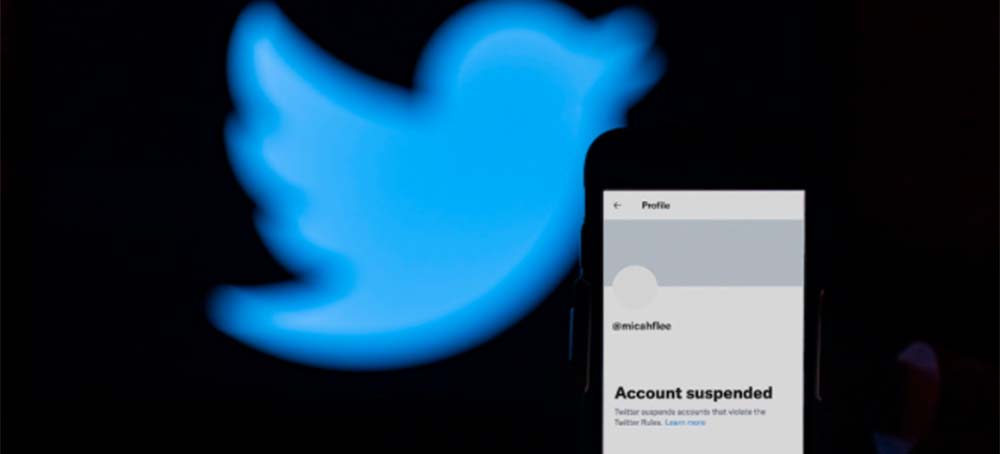 Twitter. (photo: Intercept/Getty Images)
Twitter. (photo: Intercept/Getty Images)
ALSO SEE: Elon Musk Says He Will Step Down as Twitter CEO
— Once He Finds a Replacement
To you, it looks like Musk unblocked journalists like me. It’s an illusion: The truth is that we are still locked out of our accounts.
We had all pointed out that Musk censored a Twitter account, @ElonJet, which used public data to post the location of his private jet, but that @ElonJet had moved to rival social networks, like Mastodon, that didn’t censor the account. Musk accused us of “doxxing” him by posting “assassination coordinates” and then tried to blame his outburst on an alleged stalking incident that had nothing to do with the @ElonJet account.
My suspension lasted just a few days before my account was reinstated. When people visit my Twitter profile, it no longer says “account suspended,” and it looks as if I’m back on the platform. Friends and strangers alike have reached out to me saying it’s good to see that I’m back on Twitter. It’s an illusion.
In reality, I’m still locked out of my Twitter account unless I agree to delete a specific tweet at the behest of the billionaire. Several of the other suspended journalists are in the same boat. (Twitter, where the communications team was decimated by Musk’s layoffs, did not immediately reply to a message for comment.)
When I log in to my Twitter account, the site is replaced with the message: “Your account has been locked.” Twitter accuses me of violating its rules against posting private information. (In the 13 years that I’ve used Twitter, I’ve never violated any rules, and my account has never been suspended or locked until now.)
To unlock my account, I must remove the offending tweet, which in my case said, “Twitter just banned Mastodon’s official Twitter account @joinmastodon with 174,000 followers, probably because it tweeted a link to @ElonJet’s Mastodon account. Twitter is now censoring posting the link, but the user is @elonjet@mastodon.social.”
I didn’t want to bend the knee to the Mad King of Twitter, so I submitted an appeal. “My tweet is about Twitter censoring rival social network Mastodon,” I wrote. “This is suppression of speech that never would have happened before Elon Musk took over.” After two days, I received an update from Twitter: “Our support team has determined that violation did take place, and therefore we will not overturn our decision.”
My alleged offense is that I posted private information to Twitter by linking to @ElotJet’s account on Mastodon or, in my case, mentioning the username and showing the link in a screenshot. This is on its face absurd — I didn’t post private information, much less “assassination coordinates” — but a quick Twitter search for https://mastodon.social/@ElonJet shows that plenty of other accounts have posted this same link yet aren’t locked out.
I’m not the only suspended journalist that’s locked out of my account. Some journalists like Drew Harwell of the Washington Post have written on Mastodon about being locked out. “For anyone wondering,” Harwell wrote, “I’m still unable to access Twitter until I delete this tweet, which is factual journalism that doesn’t even break the location rule Twitter enacted a few days ago.” He appended a screenshot of the tweet.
And in an interview on CNN, Donie O’Sullivan, another suspended journalist, explained that his account is locked as well. “Right now, unless I agree to remove that tweet at the behest of the billionaire, I won’t be allowed to tweet on the platform,” he said. He also submitted an appeal.
Mashable’s Matt Binder was unsuspended following the mass banning, but he wrote on Mastodon that when he wrote to a Twitter official to ask how he had broken company policy, he was then locked out. “Seems they forgot to force me to delete the tweet the first time, like they did the other suspended journalists,” he wrote.
Steve Herman of Voice of America, whose account was also suspended last week, told CNN over the weekend: “When I got up this morning, I saw a bunch of news stories that my account had been reinstated with those of the others. Well, that’s not exactly true.” Herman explained that Musk was demanding he delete three offending tweets, all about @ElotJet.
The New York Times reported that the account of its suspended journalist, Ryan Mac, was also locked, contingent on whether he chooses to delete posts that Twitter flagged as violating rules against posting private information.
Other journalists who were suspended for their @ElonJet-related tweets are now fully back, including Aaron Rupar and Tony Webster.
I personally don’t plan on submitting to Musk’s petty demands. We’ll see if anything changes. In the meantime, you can follow me on Mastodon at @micahflee@infosec.exchange, and The Intercept at @theintercept@journa.host.
READ MORE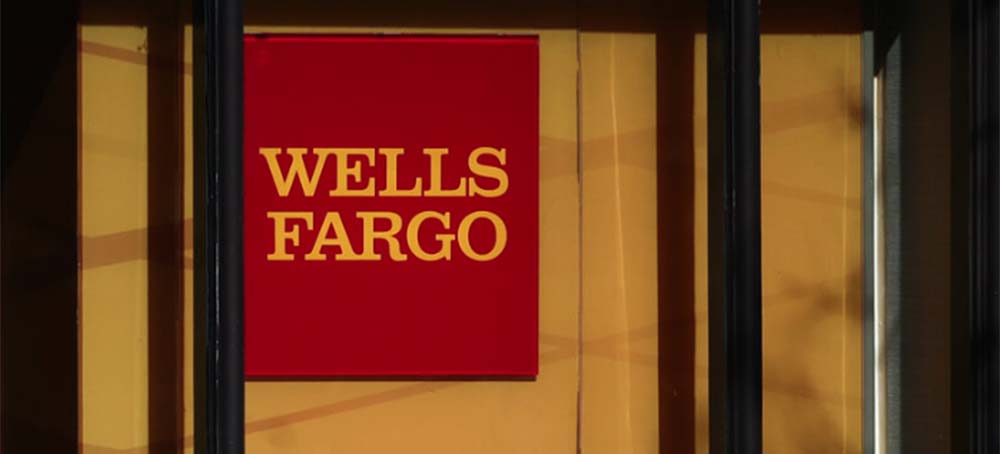 The Consumer Financial Protection Bureau (CFPB) has ordered Wells Fargo to pay billions in fines and redress to mistreated consumers. (photo: Jakub Porzycki/NurPhoto/Getty Images)
The Consumer Financial Protection Bureau (CFPB) has ordered Wells Fargo to pay billions in fines and redress to mistreated consumers. (photo: Jakub Porzycki/NurPhoto/Getty Images)
The Consumer Financial Protection Bureau said for some customers the bank's wrongdoing had especially dire consequences.
People had their cars wrongfully repossessed by Wells Fargo and the bank took actions that resulted in borrowers wrongfully losing their homes, according to the order from the CFPB. Others customers were charged improper overdraft fees on their checking accounts.
"Wells Fargo's rinse-repeat cycle of violating the law has harmed millions of American families," said CFPB Director Rohit Chopra. The bureau says the wrongdoing goes back more than a decade, with some of it continuing into this year. "The CFPB is ordering Wells Fargo to refund billions of dollars to consumers across the country," Chopra said.
Under the terms of the order, Wells Fargo will pay $2 billion to millions of customers who were harmed. The bank will also pay a $1.7 billion fine.
A CFPB official speaking on background said customers who lost their cars after they were wrongfully repossessed will receive a base amount of $4,000 each, and could receive more money depending on the particulars of their case.
Wells Fargo's CEO Charlie Scharf said in a statement, "We and our regulators have identified a series of unacceptable practices that we have been working systematically to change and provide customer remediation where warranted."
The bank framed the settlement as a way to move forward and reform the company's scandal-ridden past.
"This far-reaching agreement is an important milestone in our work to transform the operating practices at Wells Fargo and to put these issues behind us," said Scharf. "Our top priority is to continue to build a risk and control infrastructure that reflects the size and complexity of Wells Fargo and run the company in a more controlled, disciplined way."
Over the past decade the bank has endured a series of high profile and embarrassing debacles, including the revelations NPR reported on in 2016 that the banks hyper-aggressive internal sales pressure had resulted in bank employees opening millions of checking, debit, and credit card accounts for customers without their knowledge, in order for the employees to meet their sales goals.
CFPB director Chopra said this latest enforcement action is an important step, "for accountability and long-term reform of this repeat offender."
Under the order the CFPB says Wells Fargo is required to reach out to customers who were harmed and eligible for reimbursement. The bureau says customers who are experiencing ongoing problems with Wells Fargo, or other financial providers, can submit complaints by visiting the CFPB's website.
READ MORE  Iranians protest in Tehran on Oct. 27 after the death of 22-year-old Mahsa Amini. (photo: AP)
Iranians protest in Tehran on Oct. 27 after the death of 22-year-old Mahsa Amini. (photo: AP)
Many activists and analysts believe the Islamic Republic is using the death penalty to terrify demonstrators into silence.
The first known executions of people arrested over the months of protests prompted an outcry from Western governments and human rights activists, but they came as little surprise to those involved in the demonstrations or carefully watching from afar.
“They want to create fear for the people who are involved,” Saeed, a business owner in his 30s from Tehran who is very active backing the protests on social media, said by voice note. As with all those interviewed for this story inside Iran, NBC News is identifying him only by his first name to avoid possible retaliation by the regime.
“They want to show the public that their actions will not go unpunished and that there are rules in the system,” he added, and so “families stop their children from going out to protest.”
Last Monday, officials publicly hanged a man from a construction crane in Mashhad, according to Mizan, a judiciary-run news agency. Majidreza Rahnavard was accused of “waging war on God” after he was accused of stabbing to death two members of the pro-government Basij militia in the northeast city. Human rights groups and Western governments say Iran’s judicial system is based on sham trials behind closed doors.
A week earlier, Iran executed another man, Mohsen Shekari, alleging he blocked a road in Tehran and stabbed a pro-government militia member who required stitches. Around a dozen other people have been sentenced to death, according to human rights groups.
“The regime knows it is fighting for its life,” said Abbas Milani, the director of an Iranian studies program at Stanford University. In the past, the regime has been “busy simply containing” demonstrators, he added. “Now they need to put the fear in people’s hearts again.”
Executions by hanging are far from rare in Iran, which Amnesty International says put 314 people to death last year, the most in the world after China.
But many activists and analysts alike believe the Islamic Republic is using the death penalty to terrify demonstrators into silence, after other attempts failed to quell the most significant wave of dissent since its founding revolution in 1979.
“This is very standard playbook by them; they have done this at previous protests” said Ali Ansari, a professor of Iranian history at St. Andrews University in Scotland. But this time, “if anything, they are moving quicker now to execute protesters with sham trials that even their own side are criticizing.”
Some protesters say the regime may also be using executions to shore up its own supporters and reduce the risk of dissent in its ranks by showing it will deal severely with alleged crimes against members of the security forces and the pro-government militia.
“It’s like they want to tell their security agents that, ‘See, we are not letting people get away with harming you in any way,’” Saeed said.
Yan, of Tehran, an aspiring filmmaker in his 30s who was also involved in the demonstrations, said: “Some members of the Basij and security forces have died, and the regime thinks that it is their duty to take revenge. Blood for blood, an eye for an eye, this is the mentality of the regime. This means that for each and every one of their security forces who dies, they will be hanging a protester by the neck in retaliation.”
The executions have been met with a variety of emotions among Iranians at home and abroad. “My sense is one of shock, resignation and enhanced determination,” Ansari said.
Saeed said he was so despondent when he heard about the first execution last week that he was lying in bed all morning unable to move. “I woke up in the morning and saw the news,” he said. “I sat still and silent in my bed for two hours and turned off my phone and went to sleep again from sheer sadness.”
The feeling soon turned to rage, he said, coupled with a renewed fearlessness about the prospect of being jailed now that some had lost their lives.
“I must admit that I was afraid of being jailed before these executions, but now, I am thinking that I could tolerate it,” he said.
“There is no gray area left anymore” between the protesters and authorities, he added. “Either you are with the people on the side of justice or against them on the side of cruelty.”
Many people are terrified by the executions, but Saeed said that with fear comes unpredictability, which he said is a potential danger for the regime.
“Angry and scared is much more dangerous than just angry, and that is how people feel,” he said. “When you are scared and angry, you do things that are unexpected.”
The unrest broke out in mid-September, when a Kurdish woman, Mahsa Amini, 22, died in a hospital three days after she was arrested by the country’s morality police, which accused her of breaking the country’s strict dress code. A three-day nationwide strike this month saw daily life across this country of 85 million grind to a halt, and there has been a push on social media for another strike this week.
In all, at least 475 people have been killed and 18,000 others have been arrested, according to the Washington area-based watchdog group Human Rights Activists in Iran. Iran’s Interior Ministry said this month that the death toll was 200, including security forces who were killed.
“The Iranian authorities are adamant on continuing their killing spree, both on the streets and through sham trials,” Diana Eltahawy, Amnesty International’s deputy director for the Middle East and North Africa, said in a statement after Shekari was executed. “The clear aim is to instill fear among the public in a desperate attempt to cling to power and end the popular uprising.”
Amnesty has tallied 12 people it says are facing the death penalty related to the protests and five more who face trial or have been charged with crimes carrying the death penalty. Rahnavard was the sixth.
Many of those involved in the uprising say that even if the judicial killings continue, they will remain undeterred.
“Revolutions have consequences, and we need to pay the price for freedom,” Yan said. “Unfortunately, that sometimes means losing lives.”
READ MORE 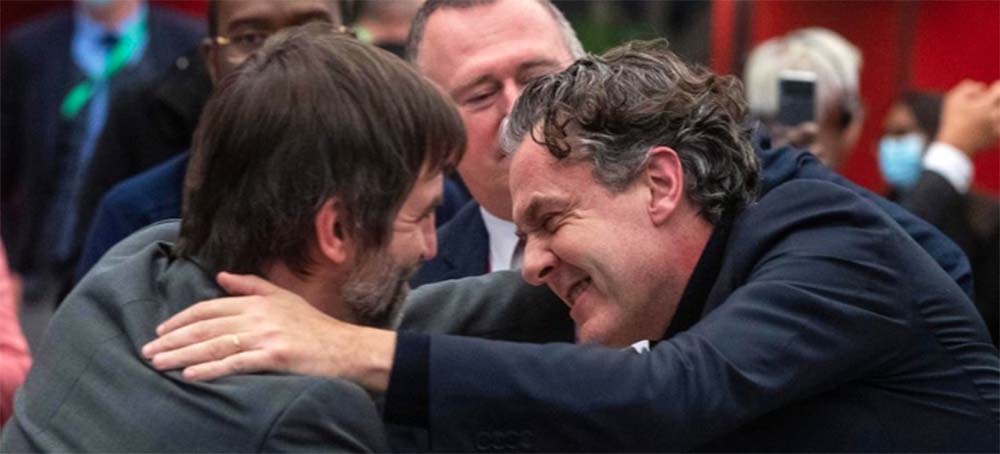 Canadian Minister of the Environment and Climate Change Steven Guilbeault, left, hugs French Minister of Environment and Ecological Transition Christophe Bechu after roughly 190 countries agreed on a historic plan to halt the decline of wildlife and ecosystems in Montreal, Canada, on December 19. (photo: Lars Hagberg/AFP/Getty Images)
Canadian Minister of the Environment and Climate Change Steven Guilbeault, left, hugs French Minister of Environment and Ecological Transition Christophe Bechu after roughly 190 countries agreed on a historic plan to halt the decline of wildlife and ecosystems in Montreal, Canada, on December 19. (photo: Lars Hagberg/AFP/Getty Images)
At the UN Biodiversity Conference in Montreal, world leaders agreed to a historic plan to halt biodiversity loss.
Adopted at a UN biodiversity conference called COP15, the agreement contains 23 targets that countries must achieve within the decade. They include conserving at least 30 percent of all land and water on Earth by 2030 — the largest land and ocean conservation commitment in history — and shrinking subsidies for activities that harm nature, such as industrial fishing.
The agreement, known as the Kunming-Montreal Global Biodiversity Framework, also commits rich countries to pay developing nations $30 billion a year by 2030 for conservation. That’s roughly a tripling of existing aid.
Environmental advocates say that this agreement could be our last chance to reverse the decline of nature. Ecosystems and the services they provide, such as pollination for food crops, are vanishing, as companies and governments bulldoze forests and prairies, and warm the Earth with greenhouse gases. One million species are now at risk of extinction and many wildlife populations have, on average, declined by nearly 70 percent in the last 50 years.
“The figures are terrifying,” Marco Lambertini, director general of WWF International, the world’s largest environmental organization, told Vox. “We’ve lost almost half of the forests, half of the coral reefs. It’s really, really bad.”
Biodiversity talks, like COP15, tend to draw far less attention than the big climate conferences — less than, say, COP27 in Egypt. Only a couple of heads of state showed up in Montreal and there were no A or B-list celebrities. Yet the agreement the conference produced is groundbreaking with wide-ranging implications for corporations, financial institutes, and governments.
“We have taken a great step forward in history today,” Steven Guilbeault, Canada’s minister of environment and climate change, said after the agreement was adopted, adding that COP15 is the most significant UN conference on biodiversity in history.
Now, attention turns to the question of whether nations will actually be able to achieve all 23 of the targets by the eight-year deadline, and what happens if they don’t. Unlike the Paris Agreement, the new biodiversity framework is not legally binding.
Here’s what you need to know about the landmark deal.
Countries agreed to nearly two dozen targets including conserving at least 30 percent of Earth within the decade
First, some quick lingo: COP15 is a meeting of countries that are members of a UN treaty called the Convention on Biological Diversity, or CBD. You can think of CBD as a contract, or agreement, between member countries to collectively sustain biodiversity (ecosystems, wildlife, and genetic diversity) and its benefits. Every country other than the Vatican is a member of the treaty — except the US.
These meetings can be chaotic and incredibly hard to follow, and they’re often overlooked by mainstream media. But this year’s event was slightly different because of a document at its center: the global biodiversity framework.
One key distinction between the framework and the Paris agreement is its complexity and scale; the Paris agreement zeroed in on one goal — to limit global warming to below 1.5 degrees Celsius — whereas this text contains nearly two dozen objectives, including a target to conserve at least 30 percent of all land and water by 2030, known as 30 by 30.
Although more than 100 countries had already agreed to 30 by 30 before coming to Montreal, it was still a point of contention at COP15. For one, it wasn’t clear what would count as “conserved” land. Some Indigenous groups were also worried that expanding the footprint of protected areas might come at the expense of their land rights. (Historically, environmentalists have evicted Indigenous people from their traditional territories in the name of wildlife conservation.)
But in its final form, the agreement indicates that a handful of different kinds of land can count toward the 30 percent target, including formal protected areas (such as national parks) and, in some cases, Indigenous territories. The final agreement also explicitly acknowledges that countries must respect the rights of Indigenous groups as they seek to conserve more land.
“The text provides a strong basis for countries to walk hand-in-hand with Indigenous peoples in addressing the biodiversity crisis and in ensuring that the negative legacy of conservation on Indigenous peoples will be corrected,” Jennifer Corpuz, a Filipino Indigenous lawyer and key negotiator for the International Indigenous Forum on Biodiversity, said in a statement Monday.
Another key target of the agreement commits countries to require large companies to disclose their environmental impacts and how dependent their profits are on ecosystems. For example, a large company that sells cacao might have to reveal how its farms impact forests and how the decline of pollinators affects its supply of cacao.
The idea is that by giving investors and consumers more visibility into a company’s footprint and nature-related risks, money will eventually move away from businesses that damage ecosystems and toward those that help restore them, according to Eva Zabey, executive director of a coalition of companies and nonprofits called Business for Nature.
A handful of other targets in the new deal are also noteworthy. Target 2, for example, commits countries to restore at least 30 percent of degraded land and water, such as prairie that was formerly farmland, whereas Target 10 calls on countries to make sure farmland, fisheries, and other productive areas are managed sustainably. Two of the targets also support nature-based solutions, a loosely defined buzzword meaning actions that help restore or conserve ecosystems while also benefitting human lives. (Regrowing coral reefs to help control coastal flooding during hurricanes is a great example.)
Arguably, however, the most important part of the framework — and its most controversial target — is about money.
The question that almost derailed the talks: Who pays for conservation?
A number you’d hear often in the halls and meeting rooms at COP15 was $700 billion.
That’s a rough estimate of the total gap in funding for biodiversity conservation worldwide, according to a widely cited report published in 2020. The report found that adequately conserving nature will cost, on average, about $844 billion a year by 2030, yet the world currently spends only a fraction of that. It costs money to set up and manage protected areas, make agriculture more sustainable, and so on.
Much of the air at COP15 was sucked up by discussions on closing that financial gap. They centered around three tense issues:
1) How much money will the world commit, in total, to biodiversity conservation each year?
2) How much of that money will wealthy nations give to developing countries?
3) Who will manage and distribute the money?
Negotiations reached a tipping point last week when delegates from developing countries including Brazil, India, and Indonesia walked out of finance talks after reaching an impasse with rich nations. “Financing is always the achilles’ heel of every global agreement,” Florian Titze, a policy advisor at WWF Germany, said at a press conference earlier this month.
By early Monday morning, however, delegates had struck a deal: In the new framework, they commit to spending $200 billion per year on conservation by the end of the decade, which will include public, private, and philanthropic support. It’s a huge sum, yet still only dents the massive finance gap.
Importantly, that money includes $20 billion in annual aid from rich nations to developing countries — which harbor most of the world’s remaining biodiversity — by 2025. The number increases to $30 billion a year by 2030.
The framework not only funnels money into conservation but aims to redirect government funds away from activities that harm nature. Countries spend as much as $1.8 trillion on subsidies that damage ecosystems, including those for fossil fuels, according to one 2022 study. Under one of the framework’s targets, countries pledged to identify harmful subsidies by 2025 and then, by 2030, shrink them by at least $500 billion a year.
These financial commitments are still unlikely to be sufficient to meet the goals of the framework, said John Tobin, a professor of finance at Cornell University (who coauthored the report that identified the $700 billion gap). There has to be a more wholesale shift in the economy, he said, toward business activities that benefit nature.
One indication that this transformation is already underway, he said, is that banks, asset managers, and other financial players attended COP15, and in record numbers. It was also the first UN biodiversity meeting that had a whole day devoted to finance.
Will any of this actually make a difference?
The world has, in a sense, been in this very position before. In 2010, at a similar UN biodiversity meeting, countries pledged to achieve 20 targets, known as the Aichi Targets, within a decade. And some of those targets sound a lot like those in the new framework — eliminating harmful subsidies is one of them, and halving the loss of natural habitats is another.
None of those targets were met. Not one. So, what will be different this time?
Countries failed to meet the Aichi Targets, experts say, for two main reasons: There was a dearth of funding for conservation, and there was no clear monitoring and reporting system to hold countries accountable. “If there’s one thing that we learned from Aichi it’s that you need to monitor,” Elizabeth Maruma Mrema, executive secretary of the Convention on Biological Diversity, said in a press conference last week.
With that in mind, delegates in Montreal also negotiated a plan to measure progress toward each target, using a series of indicators, and to report on that progress every few years. In some cases, those indicators are straightforward, such as a tally of all square kilometers of the Earth that are conserved (which is already available in public databases); others are not yet fully developed, such as indicators for corporate disclosures.
But together with a steep hike in financing, delegates and environmental advocates generally believe that the new monitoring framework will help countries avoid complete failure.
Naturally, the agreement isn’t perfect
For some delegates, money remains a concern.
Early Monday morning, when adoption of the biodiversity framework seemed imminent, a delegate from the Democratic Republic of the Congo took to the floor and explained that he could not support the deal. Forest-rich developing nations need more aid and it must be easy to access, he said. Ultimately, the delegate only briefly stalled the adoption process, but his dissent highlighted that, even after several days of late-night negotiations, not everyone is satisfied.
Some goals and targets also lack specificity, according to some environmental advocates. Countries should, for example, commit to increasing animal populations by a certain percentage, but an exact number doesn’t appear anywhere in the current agreement, according to Georgina Chandler, a senior international policy officer at The Royal Society for the Protection of Birds.
Again, there’s also a question of accountability because the agreement isn’t legally binding. Plus, it lacks a clear process for “ratcheting up” or raising the ambition of targets at regular intervals.
Yet there are plenty of other, non-legal tools to keep countries on the right track, according to Andrew Deutz, director of global policy, institutions, and conservation finance at The Nature Conservancy. A lot of it simply comes down to peer pressure, he said. “It becomes a name and shame, but also a highlight and reward,” he said — in other words, calling out countries that are behind, and praising those that are on track to hit the targets.
Ultimately, there’s no guarantee that this framework will work. But several people I spoke to in Montreal emphasized that it has to. It’s not just animals that are at stake, they said, but the ecosystems that we all depend on. There’s no human life without wildlife.
Follow us on facebook and twitter!
PO Box 2043 / Citrus Heights, CA 95611

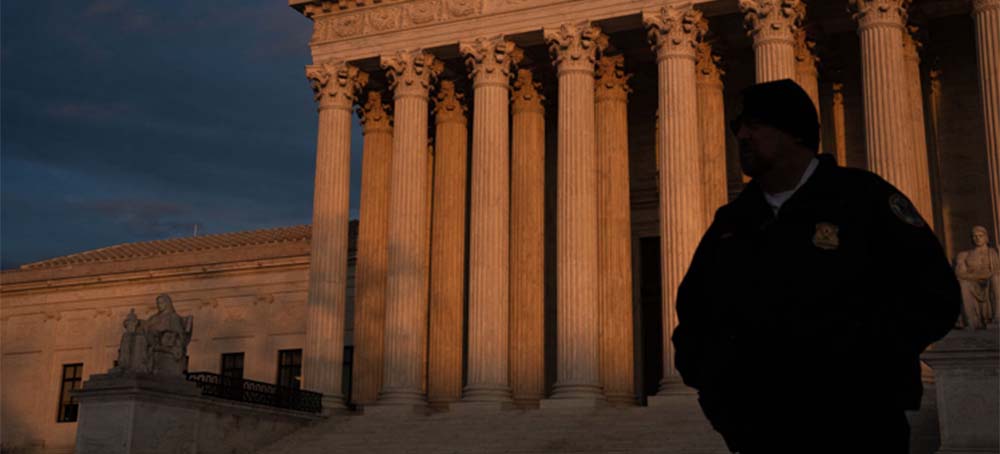

No comments:
Post a Comment
Note: Only a member of this blog may post a comment.